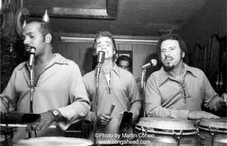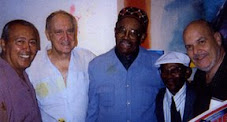
When the old
La Conga on
West 51st Street became the
China Doll overnight, the “rhumba-nik” crowd became quite concerned. Was their favorite club losing its Afro-Cuban flavor in favor of some Oriental concoction?
What happened was this: Beginning in early 1940, the Jewish community discovered chop suey, chow mein, egg foo yung, et cetera. They began to abandon Toffinetti’s Italian cuisine on Times Square in favor of Ruby Foo’s Chinese cuisine. Ruby Foo’s itself was inspired by an unknown upstairs restaurant crowded with customers at 49th and Broadway. The place was called Chin Lee’s.
Lucky Mr. Lee had a gold mine. It was not in the same order as other Chinese restaurants operating at that time. His offered a “revue,” with “no cover, no minimum.” He gave customers free tea refills unlimited and the free fortune cookie gimmick. His matchbooks published prices for a general public that mistrusted nightclub price tactics; he portrayed his establishment in this way as being forthright and honest-dealing. His matchbooks stated: Lunch. 40¢. Dinner. 80¢, except Saturday evenings. Lunch, Saturdays and holidays. 45¢. After-theater supper. 85¢. Wholesale and retail. For your health and good food. Use Chin Lee coupon books for free meal. With Chin Lee's list of twenty or thirty choices on an exotic menu, big servings of steaming hot or sour, mild or spicy rice dishes, using cheap labor and an amateur hula-hula girl revue, it was clear to Mr. Harris that his La Conga had to do something.
Chin Lee’s restaurant came to life at the end of the Great Depression’s baked beans and chili bill of fare at Horn and Hardart’s automat. He was a breath of fresh air. Furthermore, Mr. Harris saw Lee opening a second spot called Chin’s at 44th and Broadway, lit up with enormous Chinese lanterns. Even Ruby Foo’s had opened a second larger place down in South Beach, Florida, for the winter crowd. Chinese restaurants around the city were installing entertainment, finding that music and dining went well together, like corned beef and cabbage.
When it became clear that the Jewish public—comprising the majority of La Conga’s music-loving clientele—and Chinese food had discovered each other, Mr. Harris was forced to save his place by giving birth to the China Doll, if only in name. He boldly advertised it as “New York’s only Chinese nightclub,” with “shows at 8, 12 and 2:30” and “never a cover charge”—omitting reference to a minimum. “Deluxe dinners from $2.50,” giving his address as “East of Broadway,” rather than West 51st Street.
His menu was still steaks and chops, but without the Latin rice and beans plates. He had difficulty finding English-speaking help among the Chinese, and Orientals couldn’t mix drinks at the bar. Chinese food filled you and later you were still hungry—people still came to the China Doll now to dance to Machito or Noro Morales, but not to eat. Harris tried putting acts like the José Greco Dancers that broke away from the strictly Afro-Cubans…acrobats, Mexican, flamenco and Los Chaveles de España.
One night after the last couple left, he and I sat at the bar with only the bar lights on—to save electricity, I surmise. It was a somber moment even with the conga craze in full swing all over the country. He poured us double shots of his strongest rum and added, “Here’s a drink you can’t get—.” He never spoke the words “Chinese restaurants.” (The sudden growth of “Chinese” can be compared to the pizza phenomenon of the 1970s.)
He toyed with the idea of broadcasting nightly, using top personalities of stage, screen and radio, or giving free conga lessons, but his competition was getting stronger day by day. The Chinese were winning the market. Perhaps this sounds familiar, but fortune is fickle.
In 1941, Sam and Joe Barker opened the Beachcomber in Miami Beach featuring spicy dishes, tropical drinks, strong Zombies, air-conditioning and Xavier Cugat with Miguelito Valdes, “Mr. Babalu.” The Copacabana opened on East 61st Street with Carmen Miranda–type beautiful show girls all over the place. Chin Lee couldn’t compete with the “rhumba” bands and Tony Martin and Jerry Lewis floor shows. Then World War Two put the lights out on Broadway. The Chinese Chin Lees are gone now, while the Copacabana is still around.
Looking back to that era, perhaps if Mr. Lee had foreseen the future, had recognized the potential of a Chinese/Latin jazzy combination for his restaurants on that afternoon when Julio Andino, José Mangual and I with other guys were auditioning there for a “job on Broadway,” playing “Cachita” as a wild rumba for the happy customers, perhaps Mr. Lee would not have come up and asked us, “Please play American fox trots.”
 When the old La Conga on
When the old La Conga on 

2 comments:
This is an interesting perspective on the economics of nightclubs surrounding Latin music. I never would have expected the popularizatin of Chinese restuarants to effect the Latin Dance scene. I'd be curious to know how seriously this changed the amount of work bands were getting. And what happened to La Conga/The China Doll?
Thanks for your great posts, it really brings that NY era alive for me!
Hi Chip -- I think that in the era Vince was writing about, the '40s, the Latin dance scene was roaring uptown and in Spanish clubs but very much a novelty in midtown among the non-Latin crowd (which included many Jews). That novelty factor would keep clubs hot or not, and thus impact the musicians performing there. But in this era in New York, work was plentiful for musicians who could play Latin.
Post a Comment